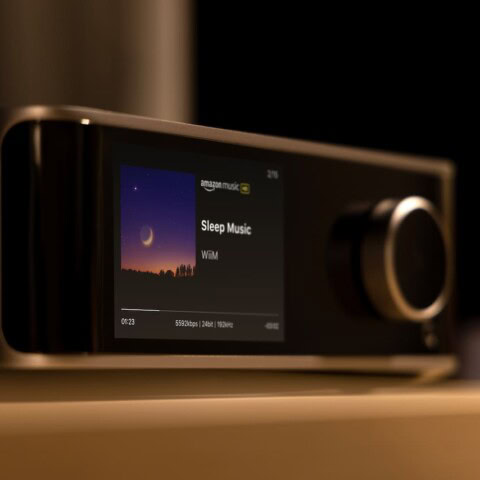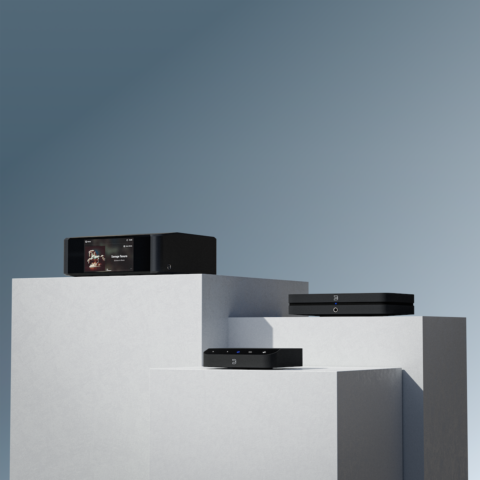$299
5 stars
At last, Mr Kramer finds an iPod dock to knock his socks off. And at a decent price, too.
After what seems like an eternity of reviewing either complex things or even worse (lots of complex things all at once), I was really looking forward to testing something simple and with as little functionality as possible. What could be simpler than an iPod dock? So the first thing out of the deepening “to be reviewed” pile was Pro-Ject’s Dock Box Fi.
This tiny box is part of Pro-Ject’s growing range of “Micro High-End Components,” as the company’s website puts it. I’m not sure I’d agree with the “High-End” but the “Micro” part is right on the money. These things are palm sized miniature audio ingots and the range covers everything from the well known phono stages to pre and power amps, CD players, tuners and of course, iPod docks.
At first I thought the “Fi” in the model name was a vaguely clever allusion to hi-fi. After all, the Dock Box Fi is meant to be a high-quality “audiophile” iPod dock but there’s an almost identical model called the Dock Box Vi. Vi? I didn’t even want to go there, but a look at the box showed that the Fi is a fixed output model, while the Vi is a variable output model designed to drive a power amp directly.
Construction and Features
At 103 x 36 x 103 (H x W x D), the Fi really is small but at almost 600 grams, it’s a lot heavier than expected, especially if you’re thinking of the ubiquitous cheap plastic docks. There’s not much to the product, just a bent metal case and a thin faceplate.
Up front you get a power LED and a remote sensor. Round back things are less stark but this is no home theatre receiver; two RCA outputs, a 16v power socket for one of Pro-Ject’s chunky wall warts, an S-Video output and a mini USB input. As soon as the iPod is docked, it starts charging and there’s no option to defeat this (as if that matters). The USB port allows you to connect the iPod to a computer to sync files.
On top, you’ll find Pro-Ject’s brilliant dock connector. Why brilliant? Instead of using one of those plastic things with a bag full of fiddly inserts, the Dock Box range has a sliding metal brace that is adjusted using a small thumb screw until it’s tight against the back of the iPod. This means the dock can easily fit most any iPod and that the back is firmly supported, so you can operate the controls without the iPod flexing scarily back and forth. You shouldn’t need to work the iPod’s controls much because the fully featured remote control will do most of the work for you.
Internally, the Dock Box Fi has been designed with audio quality in mind, so it features a discrete buffer, surface mount components for short signal paths and a low impedance output stage. Theoretically, the iPod’s output goes through an initial amplification stage and then it’s off to the amplifier, but at a low impedance. The Dock Box Fi acts as a buffer stage and it seems to work.
Sound Quality
I hooked the Dock Box Fi up to my Yamaha A-S2000 (used as a preamp), Viganoni and Viganoni Sachem monoblocks and Theophany M5 Series 2 floorstanders. Then I set my 80Gb iPod Classic on shuffle and went out for a while to let the system settle in. When I wandered back in, Beck’s ‘Paper Tiger’ from Sea Change was playing and I did a double take because I thought the CD player was on. It sounded really good, with a real sense of scale on the strings and a nice texture to the vocal. It didn’t sound like the feeble offerings that some iPod docks spew out. This was something I could live with.
Tony Joe White’s ‘Ice Cream Man’ from The Beginning sounded unfeasibly good considering the source, with depth to the soundstage, serious resolution to the guitars and a gritty roughness to the close-miked vocal. When the guitar on Stevie Ray Vaughan’s ‘Life By The Drop’ from The Essential Stevie Ray Vaughan shuffled on, I thought that this little dock sounds a lot better than it has any right to. Lots of crisp detail, good bite to the strings and again, that depth in the soundstage.
A high point was when ‘Every Planet We Reach Is Dead’ by Gorillaz (from the excellent Demon Days CD) blasted out into the room at high volume after some mellow acoustic guitar. I literally blurted out “No way!” There was no overly bright treble, no compression and no desire on my part to turn the volume down. Just big throbbing bass, huge detail and a veritable wall of smooth enjoyable sound that had me nodding along.
Listening to most of Nils Lofgren’s Acoustic Live was a pleasure, with excellent decay to the highly detailed, clear guitar notes and plenty of energy and extension to both top and bottom. This just didn’t sound anything like an iPod running into a stereo system, and every time I walked back into the room with the Pro-Ject playing, the sound quality caught me unprepared. In short, what we have here is high quality sonics from a three hundred dollar source that sounds like it should cost a lot more.
Negatives
Negatives? None! A minor point to note is that the output level from this unit was a little low and I had to crank the volume slightly higher than usual. This is only an issue for those with low gain passive preamps or 3-watt amps, and you know who you are.
It’s not the last word in hi-fi and comparisons to my excellent Marantz SA8260 SACD player showed why the Marantz has been in my system for so long. This is hardly a fair comparison and it would be churlish to detail every area where the SA8260 has an edge. Suffice to say that the SACD player gives more of everything, everywhere but it bloody well should considering both its reputation and the price differential.
Conclusion
All of the above results were achieved with 256Kb or 320Kb files. There was nothing fancy involved, no high-res files, no flashy cables and no isolation platforms (unless you count the carpet I’d dumped the dock on because the rack was full).
I don’t recall the standard Dock Box that I reviewed last year sounding quite so accomplished or composed. It’s been ages since I heard Arcam’s rDock but I’m pretty sure that it didn’t blow me away like this.
At the price, Pro-Ject’s little Dock Box Fi is absolutely beyond reproach. You can buy cheaper docks; in fact you buy all kinds of badly made tat for next to nothing, but they won’t sound as good as this. It’s way ahead of a 20-buck 3.5mm to RCA cable, which was only good at turning my iPod into an insomnia cure. A Wadia i170 iTransport accessing the iPod’s digital stream and a good DAC would be the audiophile choice at over twice the rate (and it needs a DAC) but this little gem floated my boat in a big way.
Demanding type that I am, what I really want is for Pro-Ject to hack the iPod’s digital stream Wadia style for not much more money than the Dock Box Fi, but this version will do in the interim.
Impressive? Too right. I had a total blast with my iPod on shuffle feeding this superb little device. While it won’t replace my cherished Marantz SA8260, this is the best sounding iPod dock I’ve heard yet. Respect! ASHLEY KRAMER

















All good until I got to the end. If this is the best dock you have heard, how can you recommend the Wadia as “the audiophile choice”?
A good question and well spotted. The Wadia iTransport isn’t really a dock in my book, it’s a digital transport, so no one has ever heard an iTransport on its own. It’s always the iTransport plus a partnering DAC, whereas the Pro-Ject is a complete, plug and play iPod dock solution. Pedantic? Yep.
The Wadia and something like Moon’s lovely 300D DAC would offer a far higher end sound than the Pro-Ject but it would sting the pocket to the tune of around $4K. Cheaper DACs abound, as do amps and CD players with built in DACs, which is what makes the Wadia both versatile and intriguing (and my choice if I was looking to sink some coin into that type of project – instead I reckon I may just buy this Pro-Ject).
Ash, the Wadia does have single ended outputs (RCA) + S-video so it can be used as a stand-alone dock. Where it differs from the Pro-Ject is its ability to separate the digital signal and send it via SPDIF or Toslink, turning the Wadia/Ipod into a hard drive music player. The Ipod’s internal D/A conversion is bypassed, creating a Wadia HDD player (using the sophisticated dac inside the i170).
It then becomes a pretty seriously good sounding combo, hence ‘the audiophile’s choice’.
Gah! Insert foot in mouth. Thanks Gaz. That will teach me to type comments in a hurry or to make assumptions. For some reason I’d got it into my head that the 170 was digital only. Mea culpa. I’ll have to borrow one from PQ to try against the Pro-Ject, just for kicks.
No worries old son! Still you certainly wouldn’t buy the i170 and use it as a dock, it would more than likely give very similar sound quality as the nice little Pro-Ject. I like Pro-Ject audio gear, it is very well made and the audio performance boxes well above its weight.
Well, I am puzzled. I bought the unit based on your review and the truth is this thing sucks. It distorts like crazy. At first I thought the problem was elsewhere. I re-checked cables, amps, speakers, headphones… no sire. It is the dock. I started researching online and I found quite a few others that had the same problem. The dock’s output is seriously distorted. Any potential buyers beware. There’re plenty of other good docks out there that do the job, from the NAD to the denons to Onkyo, and there’s the great digital transports like the wadia, which I own. Any of those, in their different capacities, are good choices depending on budget and your system profile, but this pro-ject box simply does not work and will ruin your music and your listening experience.
Hi Tom
Thanks for the feedback. I actually bought one of these docks after the review and I use it all the time.
I’ve currently got it hooked up to a Perreaux headphone amp and a set of Sennheiser HD650 headphones and it sounds as good as it did on the day I got it. Any distortion there must be in a frequency range only audible to bats – I couldn’t be happier with the product. In fact, it’s only a fraction behind the HRT iStreamer, if it wasn’t, I’d have upgraded to an iStreamer in a flash…I’m not brand loyal, I buy what sounds good.
You may well have a faulty unit. It happens. I’d suggest that you send yours back to the dealer and get a replacement. Keep me posted.
My Ipod does not get charged while docked. anybody else experienced the same?
“…starts charging and there’s no option to defeat this (as if that matters)”.
ehr, YES, it does matter!
– It should feature switching to allow the connected iPod or iPhone to run from the docks mains power supply or from it’s internal battery.
Running from the battery preserves the life of the iPods batteries which don’t like to be constantly charged.
256Kb or 320Kb files….?
What kind of ‘hi-if’ are we talking about?